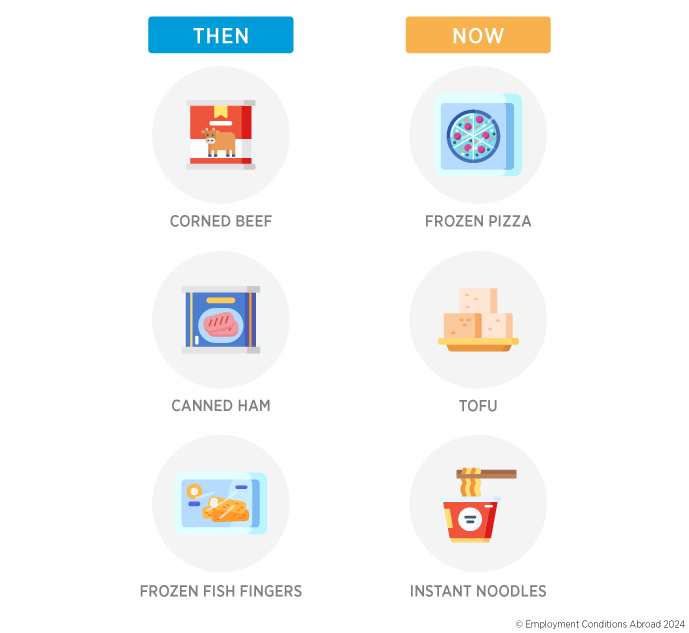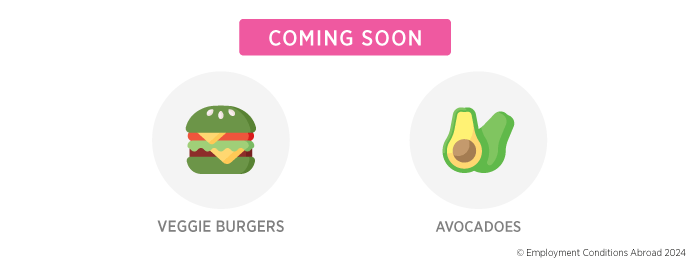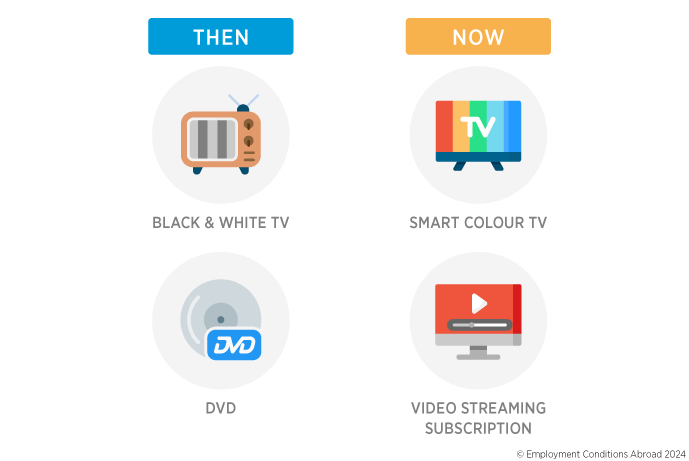Canned corned beef, camera film, DVD hire and MP3 player – all items once included in ECA’s cost of living basket. As many of you will remember (fondly or otherwise), these things used to be considered representative of consumer tastes or essential to everyday life. Over the years, they have been replaced in the basket as part of a continuous updating process. But how do we decide what’s in or out? Here we look at how ECA’s cost of living team ensures the basket is always representative and current, yet consistent over time for those using it.
What is a cost of living basket?
A cost of living basket is a collection of key goods and services that people often buy which is used to compare living costs around the world. The basket should cover a broad range of typical spending. ECA’s basket is made up of over 170 goods and services, all of which represent specific areas of expenditure, but it is not intended to cover everything people might spend their money on. For example, sporting goods are represented by tennis balls, while we have 13 different fruits and vegetables and 12 different electrical products, to represent all expenditure on these types of items.
We do not include accommodation or education costs in the basket as these are usually covered by organisations with allowances or benefits-in-kind, so do not need to be represented in the cost of living index as well. We also exclude infrequently purchased luxuries and items that are hard to measure, like jewellery or holidays, as most companies do not want to cover the difference in costs of these items.
Each of the items in the basket is weighted to reflect its relative importance in a typical household’s spending pattern in each country. These weights are calculated using data from household budget surveys published by government statistical offices, which detail average spending of households on different categories. We update these weights every six months.
Of course, thanks to continuous product innovation, new goods and services become essential, and others fall by the wayside and become obsolete. This means that unless the items in the basket of goods are regularly reviewed, many of them become irrelevant over time. A number of factors are carefully considered when choosing to add or replace items, including how widely available they are, how easy it is to price them consistently, and how relevant they are to the modern consumer.
Globally available
To compare the cost of living across the world accurately, it is vital to reference the same basket everywhere. This means choosing items that can be found and priced everywhere, including in locations where the availability of goods may vary. So, while items like branded face creams and sheet masks might be considered essential toiletries by some, they’re far harder to find globally than soap or shampoo, which represent personal care goods in ECA’s basket.
Our basket must be international to reflect global consumption patterns. While in decades past our basket was less reflective of non-Western food items, it now includes a much wider range of international groceries. For example, items such as instant noodles, tofu and sushi rice have been added over the years due to their prevalence in East Asian countries. Despite the wider range of items included, our indices can account for their relative importance to assignees from different countries thanks to our country-specific weights allocation. This means that the prices of the above-mentioned items might have more of an impact on indices for assignees from East or South-East Asia than on those for assignees from Europe.

Representing what people actually buy
Naturally, consumer spending evolves over time. By using household expenditure data, we can track these changes across various categories. Let’s take, for example, shifts in dietary preferences. An earlier version of our basket included tinned meats, like corned beef and canned ham. The world wars made these items boom in popularity, but today people spend less money on tinned products in general. Since launching our basket over 50 years ago, we have swapped food items and adapted our specifications to reflect contemporary tastes; frozen pizza, soy milk and premium ice cream are all present these days, for instance, and we will soon add veggie burgers and avocados.

Technological advancements have also been a significant factor in the development of our basket. As hard as this is for some to imagine, in 1978 expenditure on communication was solely represented by the cost of inland postage. The ease and speed of communication has since undergone a complete revolution, and with internet access now considered a necessity, the basket includes the cost of broadband internet, as well as prices of mobile phones and mobile phone contracts.
The biggest changes have come in the electrical goods section and yet, even here, it has been a process of evolution – we keep careful pace with contemporary spending patterns and tastes, without rushing into a total upheaval that could turn out to be unjustified. Media consumption in the earliest version of the basket was reflected through the inclusion of both black-and-white and colour televisions. The smart flat screen TV we price now is barely recognisable in comparison to those predecessors. On top of this, we have adjusted our specification to reflect the development of screen type and size, initially pricing 20-inch CRT screens whereas 40-inch and 50-inch LCD and OLED screens are required now. How media is consumed has also improved in terms of convenience and portability, and we have therefore introduced items like tablet computers. We have also replaced physical media with the contemporary equivalents; for example, DVD hire is no longer in the basket, with video-streaming subscriptions taking its place.

Consistent
While it is vital to reflect how consumer spending evolves with time, it is also important that we don’t thoughtlessly rush into modifications, because having a consistent basket allows us to best capture changes in the cost of living from survey to survey.
Through our long-term monitoring of household expenditure surveys, we can expertly identify the difference between genuine trends and temporary fluctuations in consumer spending. For example, to manage the impact of the Covid-19 pandemic, we disregarded fleeting shifts in spending patterns, while also monitoring which trends have continued post-pandemic. For example, there were famously some dramatic short-term booms in toilet roll and tinned food spending during the height of the pandemic, which of course would not have been appropriate to reflect in our basket weighting! Meanwhile, we have taken a gradual approach to reflecting the changes in spending on food and recreational goods which have instead outlived the pandemic.
Evolution not revolution
It is essential that cost of living indices are consistent so that mobile employees are confident that adjustments made to their salaries protect the purchasing power that they would have at home. But as we’ve seen, product innovation and spending patterns evolve and change over time, so it is also vital that cost of living baskets are carefully adapted to keep them relevant. ECA has more than 50 years of experience expertly balancing these competing principles, achieving them through incremental and considered rather than drastic changes. And no matter how consumer goods and spending patterns evolve next, you can rest assured that we will continue to do so for the next 50 years, too!
FIND OUT MORE
ECA publishes cost of living data for more than 500 locations around the world. Learn more about ECA’s cost of living data by downloading our FREE cost of living white paper which explains how ECA's indices are calculated and applied to protect the buying power of people moving between countries as well as looking at what causes them to change over time.
It is available from ECA as part of a subscription or as one-off calculations. It is also built in to ECA’s Build-up, Net-to-Net and Cost Estimate Calculators which enable calculations in seconds. Cost of living data is also pre-populated in ECAEnterprise, our Assignment Management System.
Please contact us to speak to a member of our team directly.